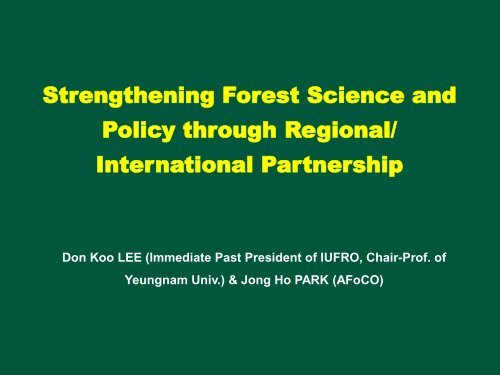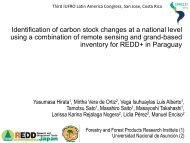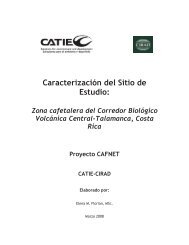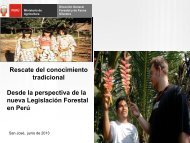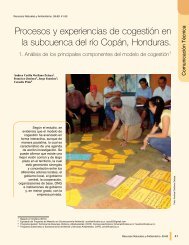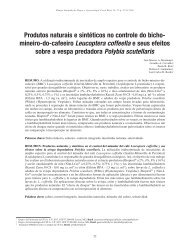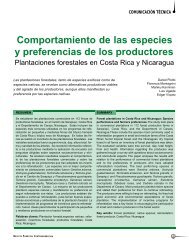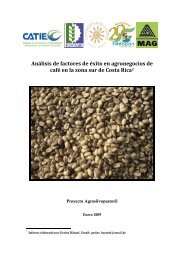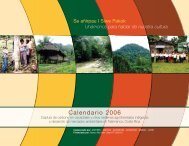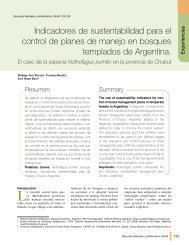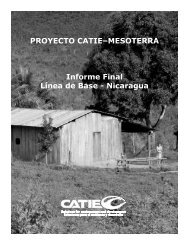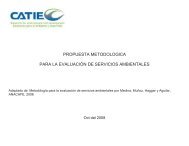International Partnership
International Partnership
International Partnership
Create successful ePaper yourself
Turn your PDF publications into a flip-book with our unique Google optimized e-Paper software.
1. Challenging Forestry IssuesFood Insecurity and Progress Towards Meeting MDG Target5• 1985 − 1995: Population increase: 1.6%• 1990 − 1997: Grain production increase: 1.0%1950 : 0.23 ha/person1996 : 0.12 ha/person2030 : 8 billion (est.population) 0.08ha/person2010 – 2012:• 870 million undernourished• 12.5% of world’s population (1 in8 people)MDG target –> halvingundernourishment in developingworld by 2015Source: FAO. 2010. The State of Food Insecurity in the World
2. Korea’s ForestsHistory of Reforestation in Korea7
2. Korea’s ForestsChallenges & Overcoming Deforestation in Korea8Lack of basic information and data• Survey of national and private forest• Identification of forest land-use category (67-69)• Establishment of Tree Breeding Research Institute (TBRI)Lack of technology, funding, and human resources• Support from the international community such as UNDP, FAO, WFP,IBRD, etc.• R&D by TBRI / Korea-Germany Forest Management Program• Establishment of Sallimgye (community based forest management) /Linking with Saemaul Undong (New Village Movement)
2. Korea’s ForestsChallenges & Overcoming Deforestation in Korea9Poor seed sources and seedling production• Establishment of seed orchard and designation of seed stand• Development of nursery clustersFuelwood needs nationwide• Fuelwood plantation (640,000 ha)Slash-and-burn farming practice• Slash-and-burn control (86,073 ha)Poor law enforcement and governance• Establishment of the Korea Forest Service• Strong law enforcement through transferring forest sector tasks
2. Korea’s ForestsSaemaul Undong (SU) and Korean Community Development10Saemaul UndongInitiated in 1971Three slogans: diligence, self-help and cooperationFactors promoted by SU:1 Educational factor (human resources capacity buildingdeveloped)2 Environmental factor (environment improved)3 Social factor (income increase emphasized)4 Creative power of human being (more dynamic societybuilt)Change in the way of thinkingCAN DO, WILL DO, MUST DO spiritNEED-virus: hungry for food, learning, clean leadership,etc.)
3. Strengthening Science and Policy Interaction at Regional/ <strong>International</strong> LevelChanges in educational curricula11Changes in educational curriculaBiodiversityClimate change (Carbon sequestration)Desertification, Land Degradation &Drought(DLDD)Water and soil pollutionEcosystem management includinghumans, forest sustainability, non-timberforest products, and recreation
3. Strengthening Science and Policy Interaction at Regional/ <strong>International</strong> LevelCapacity Building of Human Resources12Producing experts through formal educatione.g., Open university• to produce forestry experts with high quality and specialized skillsCapacity building of human resourcese.g. tree doctor, information and networkingexploring new medicines from plantsFAO, CIFOR, World Bank, etc.
3. Strengthening Science and Policy Interaction at Regional/ <strong>International</strong> Level<strong>International</strong> education programme13<strong>International</strong> education programmeActive support program forest studyto improve educationTapping foreign experts for theimprovement of the programsRecruit/exchange foreign studentsContribution of trained students inforestry-related institutes andindustries
3. Strengthening Science and Policy Interaction at Regional/ <strong>International</strong> Level<strong>Partnership</strong> and Networking14Investing on research and development•UN Eco-Peace Leadership Training Center: need for education indeveloping countries•Need for providing extensive network in doing research and activitiesrelated to the rehabilitation and management of forests<strong>Partnership</strong> and networkingCollaborative partnership and networking among universities, institutes,government, industries and private companies
3. Strengthening Science and Policy Interaction at Regional/ <strong>International</strong> Level<strong>International</strong> <strong>Partnership</strong>15IUFRO (<strong>International</strong> Union of Forest Research Organizations)- http://www.iufro.org
3. Strengthening Science and Policy Interaction at Regional/ <strong>International</strong> Level<strong>International</strong> <strong>Partnership</strong>16FAOFAO-Forestryhttp://www.fao.org/forestryEFIhttp://www.efi.int/portal/
3. Strengthening Science and Policy Interaction at Regional/ <strong>International</strong> LevelKorea’s <strong>International</strong> <strong>Partnership</strong>17Asian Forest Cooperation Organization (AFoCO)http://www.afocosec.org/index.jsp
3. Strengthening Science and Policy Interaction at <strong>International</strong>/ Regional LevelKorea’s <strong>International</strong> <strong>Partnership</strong>18UN Convention to Combat Desertification (UNCCD)The Changwon InitiativeObjectiveTo complement The Strategy through target-setting and the consolidation of effectivepartnerships, in order to enhance the implementation of the UNCCDScientific Process towardTarget-SettingMobilizing additional resources andFacilitating partnership arrangementsLand for Life Award• Agreement on SpecificTarget-Setting• Refinement of ImpactIndicators for Monitoring andAssessing DLDD Processes• Support AHTEG onScientific Advise• <strong>Partnership</strong> Arrangement- Support NAP alignment process- DSS prevention/mitigation- SLM synergistic activities- S-S and N-S cooperation• Engagement of Private Sector• Encourage SLM –related actions andpractices• Operated by multistakeholderpartnership
Conclusions19Regional/international issues in forestry/forest science suchas climate change, degradation of forest ecosystems,desertification, forest fire, and among others are trulyalarming and interrelated, and thus must be given attention.To strengthen forest science and policy -> change theeducation curricula, enhance international educationprogramme, invest on R & D, and improve partnership &networking. Capacity building of human resources is crucial,as best exemplified by the successful case of Korea.To sustainably manage our forests, cooperation at variouslevels with multi-stakeholders is important to facilitate theexchange of knowledge in implementing sustainabledevelopment and to strengthen interface of forest scienceand policy.
Thank you! Gracias!감사합니다!20


